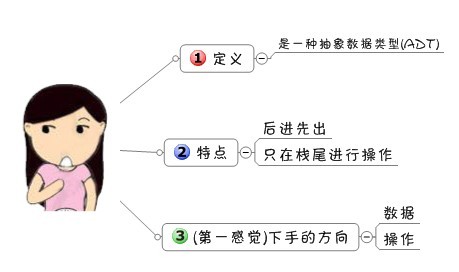我一直在想一个问题,我怎么能把一件事情说的明白呢?尤其是程序方面的知识点。思路清楚是非常重要的(只有思路清楚,表达清楚了,才能一目了然),这个清楚的思路怎么表现出来?我努力去做这件事情。这篇主要围绕堆栈来展开话题。




1、先把你要做的事情准备好。
/* ===========数据 */ #define STACK_INIT_MAXSIZE 100 char stack[STACK_INIT_MAXSIZE]; int top = -1; /* ===========操作 */ void push(){ } void pop(){ } char get_top(){ } int is_empty(){ } int is_full(){ }
这么一罗列,一下就明朗了!
2、开始逐步实现每一个函数。
/* * 用一个静态数组实现堆栈 * * (C) Copyright 2013 Chuan Shanjia */ #include <stdio.h> #include <assert.h> #define STACK_INIT_MAXSIZE 100 char stack[STACK_INIT_MAXSIZE]; int top = -1; /* ===========基本操作 */ void push(char *value) { assert(!is_full()); stack[++top] = *value; } void pop() { assert(!is_empty()); top--; } char get_top() { assert(!is_empty()); return stack[top]; } /* ===========额外操作 */ int is_empty(){ return top == -1; } int is_full(){ return top == STACK_INIT_MAXSIZE - 1; }
top存储堆栈顶部元素的下标值。开始由于没有顶部元素,所以初始值为-1,提示堆栈为空。
pop函数不需要从数组中删除元素,只减少顶部元素的下标值就足矣。
3、现在测试一下上面的堆栈的正确性(在上面的代码文件中,添加如下代码)。
void print_stack(){ int i = top; for(; i >= 0; i--){ printf("%c ", stack[i]); } printf("\t"); printf("栈顶元素:%c", get_top()); } int main() { char c; scanf("%c", &c); while(c != '#'){ if(c != '\n') push(&c); scanf("%c", &c); } printf("========打印堆栈\n"); print_stack(); printf("\n"); printf("========出栈一次,打印堆栈\n"); pop(); print_stack(); printf("\n"); return 0;
}
打印结果如下:
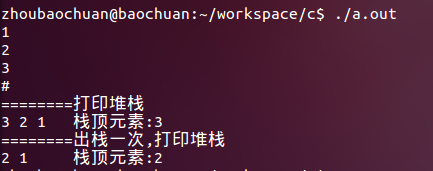
动态数组的特点:运行时才决定数组大小。——故需在原有的操作上,添加几个操作。
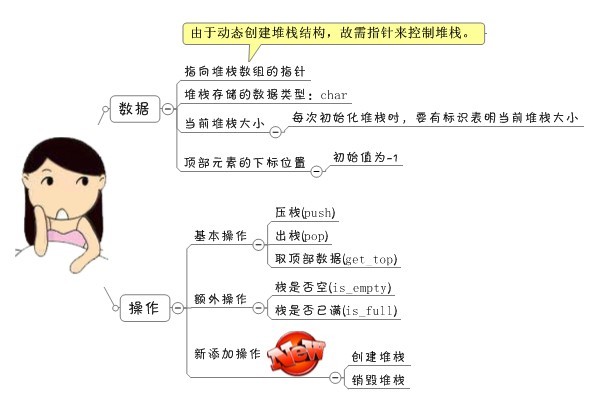
1、先把你要做的事情准备好。
/* ===========数据 */ char *stack; int stack_size; int top = -1; /* ===========操作 */ void create_stack(){ } void destroy_stack(){ } void push(){ } void pop(){ } char get_top(){ } int is_empty(){ } int is_full(){ }
2、开始逐步实现每一个函数。
#include <stdio.h> #include <assert.h> #include <malloc.h> /* ===========数据 */ char *stack; int stack_size; int top = -1; /* ===========操作 */ void create_stack(int size){ assert(size > 0); stack_size = size; stack = (char *)malloc(stack_size * sizeof(char)); assert(stack != NULL); } void destroy_stack(){ assert(stack_size > 0); free(stack); stack_size = 0; stack = NULL; } void push(char *value){ assert(!is_full()); stack[++top] = *value; } void pop(){ assert(!is_empty()); --top; } char get_top(){ assert(!is_empty()); return stack[top]; } int is_empty(){ assert(stack_size > 0); return top == -1; } int is_full(){ assert(stack_size > 0); return top == stack_size - 1; }
3、现在测试一下上面的堆栈的正确性(在上面的代码文件中,添加如下代码)。
void print_stack(){ int i = top; for(; i >= 0; i--){ printf("%c ", stack[i]); } printf("\t"); printf("栈顶元素:%c", get_top()); } int main() { char c; create_stack(100); scanf("%c", &c); while(c != '#'){ if(c != '\n') push(&c); scanf("%c", &c); } printf("========打印堆栈\n"); print_stack(); printf("\n"); printf("========出栈一次,打印堆栈\n"); pop(); print_stack(); printf("\n"); destroy_stack(); return 0; }
打印结果如下:

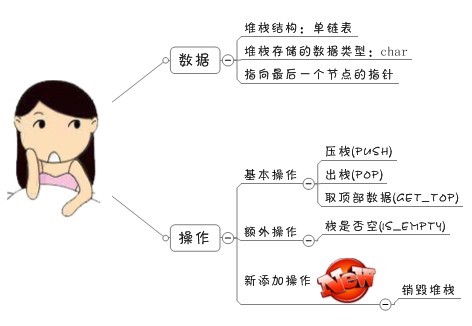
push和pop我们可以这样考虑,就是移动最后一个节点上的指针。push就把最后一个节点指针向后移动一位,pop就把指针向前移动一位。
1、先把你要做的事情准备好。
struct stack_node{ char data; struct stack_node *prev; }; struct stack_node *current; /* ===========基本操作 */ void push(){ } void pop(){ } char get_top(){ } /* ===========额外操作 */ int is_empty(){ } void destroy(){ }
2、开始逐步实现每一个函数。
#include <stdio.h> #include <stdlib.h> #include <assert.h> struct stack_node{ char data; struct stack_node *prev; }; struct stack_node *current; /* ===========基本操作 */ void push(char *value){ struct stack_node *new = (struct stack_node *)malloc(sizeof(struct stack_node)); assert(new != NULL); new->data = *value; new->prev = current; current = new; } void pop(){ assert(!is_empty()); struct stack_node *last_node = current; current = current->prev; free(last_node); } char get_top(){ assert(!is_empty()); return current->data; } /* ===========额外操作 */ int is_empty(){ return current == NULL; } void destroy(){ while(!is_empty()){ pop(); } }
3、现在测试一下上面的堆栈的正确性(在上面的代码文件中,添加如下代码)。
void print_stack(){ struct stack_node *print_node = current; while(print_node != NULL){ printf("%c ", print_node->data); print_node = print_node->prev; } printf("\t"); printf("栈顶元素:%c", get_top()); } int main() { char c; scanf("%c", &c); while(c != '#'){ if(c != '\n') push(&c); scanf("%c", &c); } printf("========打印堆栈\n"); print_stack(); printf("\n"); printf("========出栈一次,打印堆栈\n"); pop(); print_stack(); printf("\n"); destroy_stack(); return 0; }
打印结果如下:
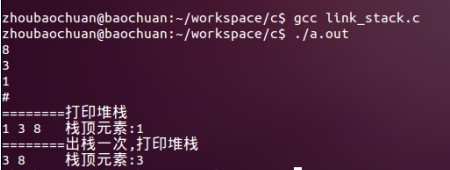
以上三种方案我们要找到它们的特点:
静态数组堆栈要求结构的长度固定。而且这个要在编译时确定(我们用define定义)。——此方案最简单、最不容易出错。
动态数组堆栈我们可以在运行时才决定数组的长度。——在复杂性和平衡性之间做权衡。

链式结构堆栈每个元素在需要时才单独进行分配,这种方式对元素的数量几乎没有限制(排除考虑内存大小)。——最大程度的灵活性,需要消耗一定的内存,访问特定元素的效率不如数组。
最后,希望我的这篇博文对你有所帮助。
推荐

喜欢编程

 我一直在想一个问题,我怎么能把一件事情说的明白呢?尤其是程序方面的知识点。思路清楚是非常重要的(只有思路清楚,表达清楚了,才能一目了然),这个清楚的思路怎么表现出来?我努力去做这件事情。这篇主要围绕堆栈来展开话题。
我一直在想一个问题,我怎么能把一件事情说的明白呢?尤其是程序方面的知识点。思路清楚是非常重要的(只有思路清楚,表达清楚了,才能一目了然),这个清楚的思路怎么表现出来?我努力去做这件事情。这篇主要围绕堆栈来展开话题。
